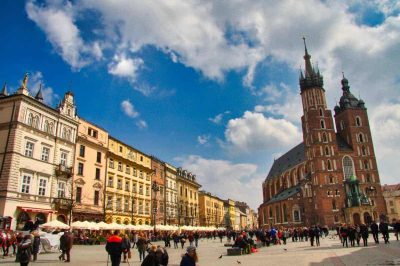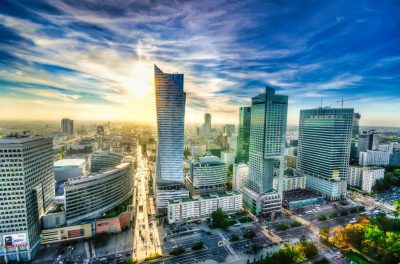We have already visited numerous cities in Poland for our blog and many of you have probably already been to Krakow, Warsaw or Gdansk. But Lodz? Although it is the third largest city in Poland, it is often overlooked by tourists and has long been considered unsafe, boring and dirty. However, a lot has changed in recent years and today Lodz is one of the most exciting cities in Poland. In this article, we want to dispel the prejudices surrounding Lodz and show you the most exciting sights in Lodz.
This is Lodz
Lodz (Polish: Łódź, pronounced Wuhdsch) is located in the heart of Poland and is the capital of the voivodeship of the same name. Around 20 years ago, it was the second largest city in the country after Warsaw, but then had to contend with a massive decline in population. This is mainly due to the decline of traditional industries such as the textile industry, but also to the proximity to the capital Warsaw, which is booming like no other in Central or Eastern Europe and attracts young, well-educated people from Lodz with higher wages.
Ditch the gray veil and head out into the countryside!
A few years ago, Lodz was still a relatively gray city, but now things are changing. Every corner is being built, restored and greened, making the city almost unrecognizable. Contrary to preconceptions, Lodz is very green. Among the most beautiful sights in Lodz are the numerous parks in the city, 34 in total. The city also boasts two nature reserves, a botanical garden and Las Łagiewnicki (1200 hectares!), one of the largest urban forests in Europe. So if you want to take a break during your tour, you have plenty of opportunities to do so.
The history of Lodz
But before we take you on a tour of the sights in Lodz, we would first like to briefly show you the history of the city, because without knowing it, it is hard to understand why Lodz is the way it is today.
The history of Lodz goes way back to the Middle Ages, and in 2023 it will be celebrating its 600th anniversary. However, repeatedly slowed down by fires and outbreaks of plague, Lodz was an inconspicuous little town for a long time.
At the beginning of the 19th century, not even 500 people lived in Lodz. However, when the city became part of the Kingdom of Poland after the Congress of Vienna, which was in personal union with the Russian Tsarist Empire, this was to change abruptly. The Tsar was looking for a place to create an economic zone for textile production. Uniforms in particular were needed. Due to the many rivers (around 20) in the city area and the forests in the surrounding countryside, Lodz was ideal for this. However, as the local population lived from agriculture and there was a lack of know-how, textile workers were recruited from Saxony(Chemnitz was considered the textile capital of Germany), Brandenburg and Bohemia and lured with numerous tax and economic incentives.
Lodz quickly grew into the “Polish Manchester” and the population literally exploded within a few decades. Initially dominated by German settlers, more and more Poles later moved to the town, where Jews were also allowed to settle from 1840. In addition, many Russians were sent to the city from faraway St. Petersburg, mainly to work in administration. This is why Lodz is also referred to as the “city of four cultures”. The city grew and grew and wool and cotton were produced everywhere, huge factories were built that resembled small towns in the city.
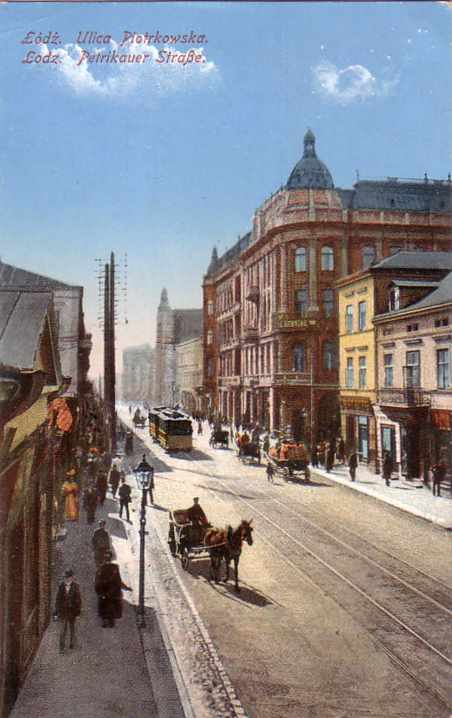
If you want to feel the special spirit that characterized Lodz at the end of the 19th century, you should definitely read the book “The Promised Land” (Polish: “Ziemia Obiecana”) by Polish Nobel Prize winner Władysław Reymont, who paints a unique portrait of those years and describes the story of a Polish, a Jewish and a German industrialist. The book was also made into a film by Andrzej Wajda, among others.
The First World War and the crisis years
The First World War and the accompanying German occupation marked a decisive event. At that time, many factories had to make their machines available for armaments purposes, others were simply dismantled and melted down. After the war, many factories went into decline and some had to merge in order to stay afloat.
Second World War – Litzmannstadt and the ghetto
But even worse was to come. Although the Second World War had less of an impact on the building fabric, it was particularly catastrophic for the Jewish population, which at the time made up around a third of the city’s population, which had grown to 700,000. The town was annexed to the Warthegau and the Nazis quickly established a reign of terror. As early as November 1939, almost all of the city’s 200 synagogues were destroyed, with only one remaining (no longer accessible today). In 1940, the Nazis renamed Łódź Litzmannstadt in honor of a general from the First World War.

Between February and April 1940, the Jews were given the choice of leaving the city or moving to the newly created ghetto. It existed until August 1944, making it the longest existing ghetto in the Nazi-occupied territories. At the same time, it was the largest after the Warsaw Ghetto. Jews from other parts of Europe were also deported here, including from Luxembourg and Trier. Poles and Roma from Burgenland also lived here in a separate area of the ghetto. It is estimated that a total of around 200,000 people passed through the Litzmannstadt ghetto.
The ghetto was divided into two parts, which were connected by bridges. The living conditions were terrible, hunger and typhus were the order of the day. The ghetto also included the Jewish cemetery, which we will introduce to you below. Around 40,000 people died in the ghetto, most of the others were taken to extermination camps such as Kulmhof. With the liberation of the city by the Red Army, the German reign of terror came to an end.
Lodz under socialism
Fortunately, the city was hardly destroyed in the Second World War. As Warsaw was completely in ruins, Lodz served as the Polish capital for a short time, and there were even plans to abandon Warsaw altogether and move the capital here permanently. However, this idea was quickly abandoned. The textile companies were nationalized and, as before the First World War, Lodz became the most important textile location in Poland, producing mainly for the Soviet and domestic markets.
Decline and resurrection
With the fall of communism, the most important sales market for textiles for decades suddenly collapsed. There were some failed privatisations, bankruptcies and mass redundancies. At times, around 25 percent of the inhabitants of Lodz were unemployed. It was not until the turn of the millennium that hope slowly began to rise again. In the meantime, there is no longer any sign of the gloom of the reunification period. Young start-ups are setting up shop in old factory buildings, renovations and construction are taking place everywhere and Lodz has made a name for itself internationally as a fashion and creative city. Anyone who was here a few years ago will hardly recognize Lodz, it is so exciting and diverse today.
These are the most beautiful sights in Lodz
But enough preamble, I’m sure you’re already looking forward to the most interesting places in the city. Here we present our personal highlights of the sights in Lodz!
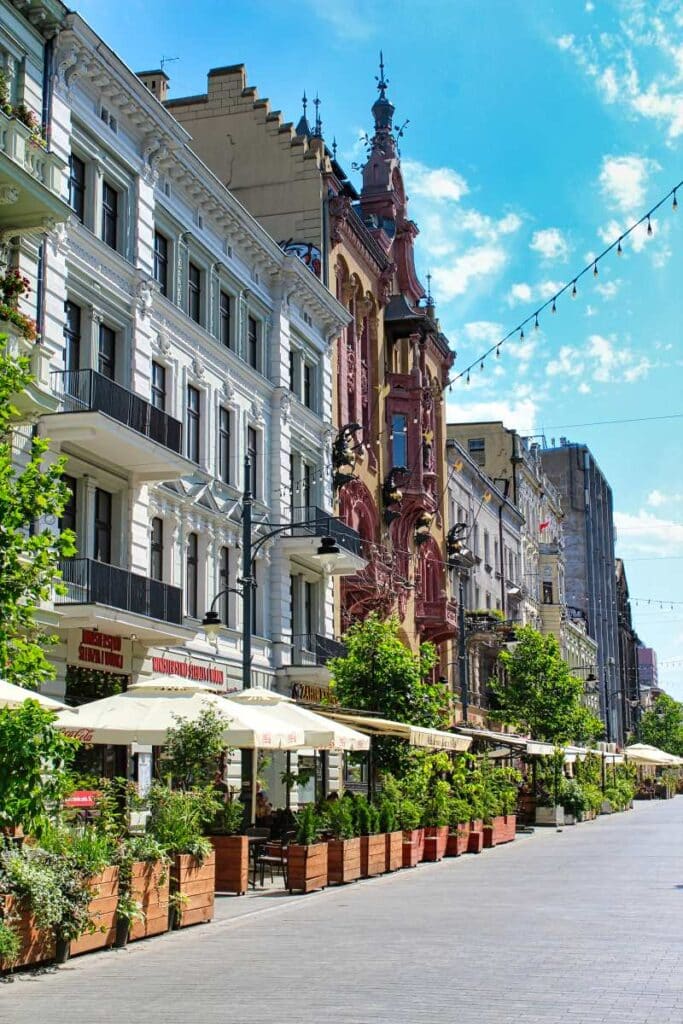
Piotrkowska Street
There really is no way around it. Piotrkowska Street (Polish: ulica Piotrkowska) is over four kilometers long and was once the longest shopping street in Europe. It runs from Plac Wolności (Freedom Square) to Plac Niepodległości (Independence Square) and used to mark the route to Piotrków (Petrikau), today’s Piotrków Trybunalski. It’s hard to know where to look when walking along what is perhaps the most important sight in Lodz – Piotrkowska is so beautiful. This is mainly due to the countless palaces and stately townhouses and commercial buildings that were built here from the middle of the 19th century. Not all of them have been restored yet, but the street, some of which is beautifully planted with plane trees, has regained its former glory from around the turn of the century.

The buildings on Piotrkowska Street are now home to countless bars, pubs (there are said to be around 100!) and cafés. However, it is no longer a shopping street with luxury brands as it was around 1900; under socialism it was mainly home to simple stores and today Italian fashion brands dominate.
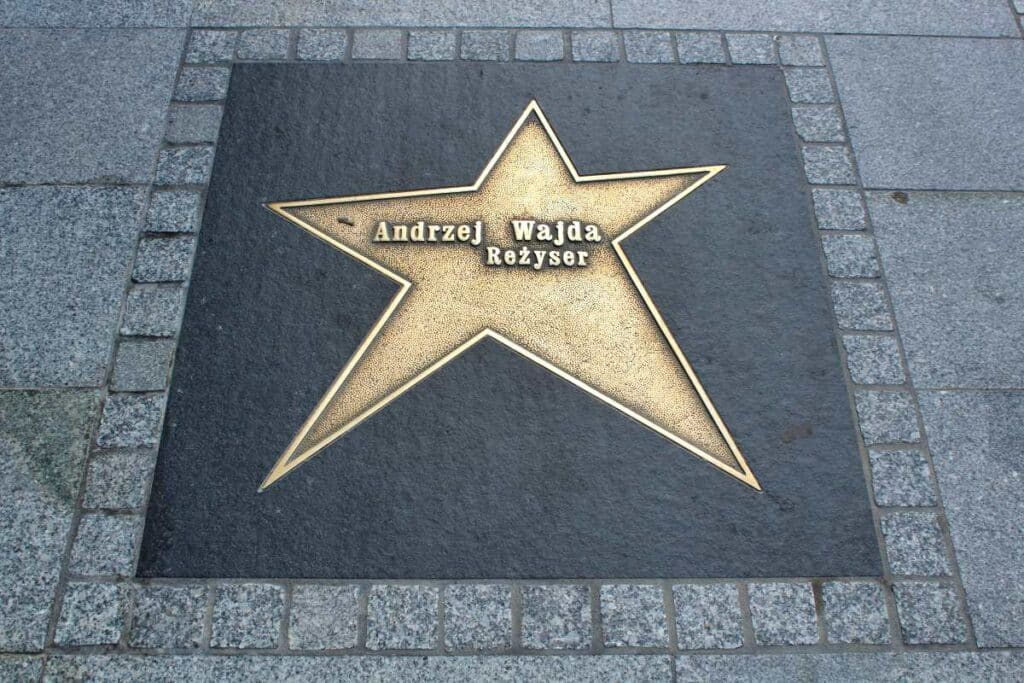
In addition to the many beautiful buildings, the street is also known for the “Walk of Fame” (Aleja Gwiazd) initiated by Polish actor and director Jan Machulski, which honors famous Polish actors on one side and directors, cinematographers and other filmmakers on the other – Lodz was and is a film city, as you will see later.
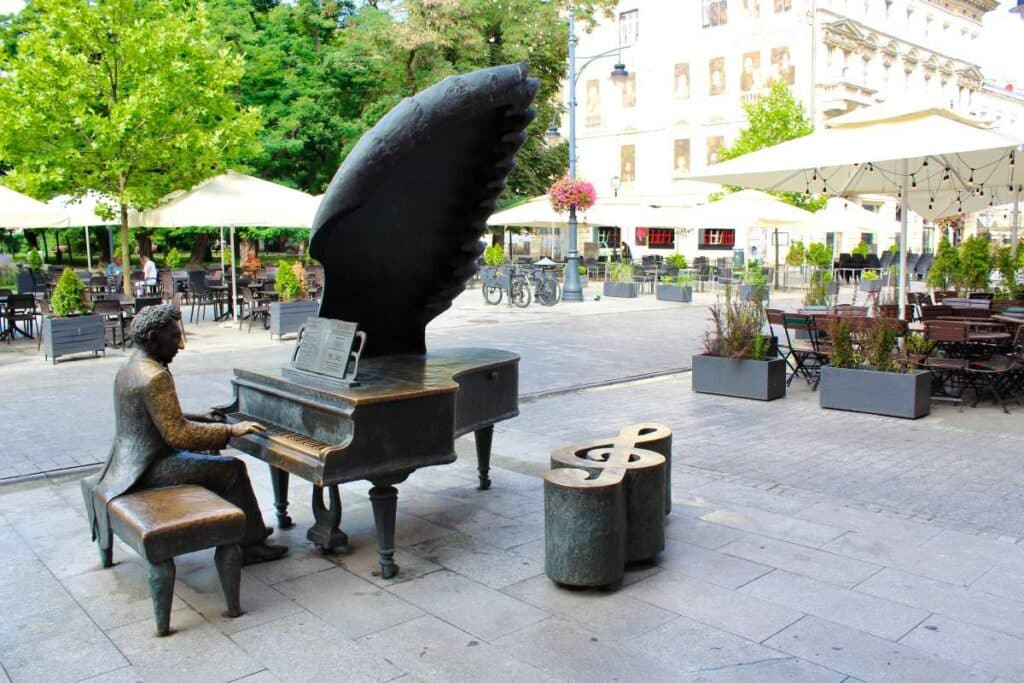
A total of six monuments also commemorate famous daughters and sons of the city, including Artur Rubinstein, who performs one of his works on the grand piano here.
But you should definitely also take a look at the many beautiful side streets. We particularly liked two of them, ul. Romualda Traugutta and ul. Stanisława Moniuszki with its many neoclassical buildings. The latter once belonged to the factory owner Ludwig Meyer, who created a building ensemble here for eternity. He also had the Grand Hotel built at 72 Piotrkowska Street, the oldest hotel still in existence in the city. An investor has now been found and the building is being renovated so that you will soon be able to stay here again.

In Off Piotrkowska (number 138), on the other hand, you will find a small creative area with numerous fashion boutiques and cool restaurants. There are also two large street art paintings here.

The Rose Passage (Pasaż Róży) is also a real eye-catcher. It was created in 2013/2014 by Joana Rajkowska, and anyone who has ever been to Warsaw will certainly be familiar with her most famous work, the giant palm tree in the city center. Her daughter Róża (“Rose”) suffered from eye cancer, which could be cured. Inspired by this, Rajkowska created an entire street of small mirrors that symbolize the transition from blindness to sight and is one of the coolest photo motifs in the city.

Manufactory
No other sight in Lodz is so emblematic of the incredible transformation that the city has undergone over the last two decades. The Manufaktura used to be a 27-hectare factory site where the Jewish entrepreneur Izrael Poznański laid the foundations for his huge cotton empire and built one of the largest factories in the world at the time. A brick-dominated plant was built in which thousands of people worked simultaneously. Poznański had his own cotton plantations in Asia and Russia and was therefore able to control almost the entire production process. After his death in 1900, however, his company quickly went into decline.
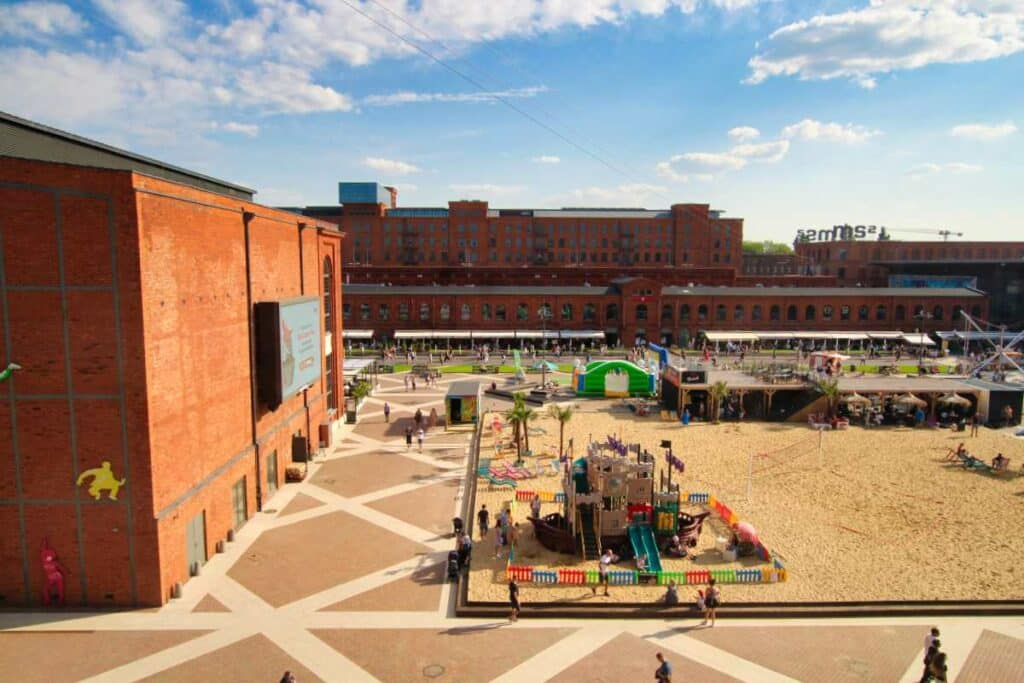
The company was then nationalized during the socialist era, and since 2006 it has been a modern leisure area with a similar function to market squares in other Polish cities. There are countless restaurants, cafés, movie theaters and stores to discover, as well as several museums. In summer, there is also a small beach where you can relax.
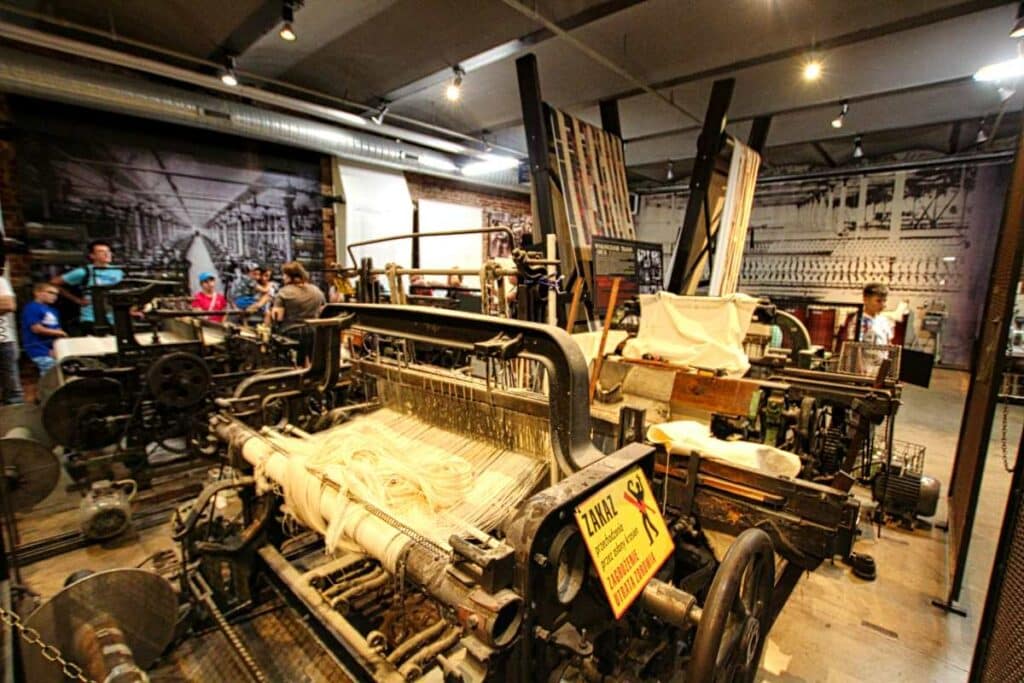
Muzeum Fabryki
One of the Manufaktura buildings is now home to the factory museum. Here you can find out about the history of the plant. The exhibition is not particularly large, but it is well done. We thought it was really cool that the old mechanical looms can still be put into operation and the weaving shuttle can be shot back and forth with a deafening noise. You can also find out exactly how cotton is actually produced and how versatile this material can be. In the same building, one floor below, you can race across the entire factory site on a zipline. Only for those with a head for heights, but a unique experience.
ms2
If you are interested in modern art, you should not miss the branch of the art museum in the Manufaktura. Some of the most famous Polish representatives of the 20th and 21st centuries can be seen here. The exhibitions are organized by theme, giving you a good insight into the development of Polish art in recent decades, with not only paintings but also installations, sculptures and videos on display. Foreign artists are also represented here with works, for example there are several works by Joseph Beuys to marvel at. Changing exhibitions on the first floor bring you closer to other artists.

Poznański Palace and Museum of the City of Lodz
Right next to the Manufaktura is a magnificent palace that you can hardly get enough of. It belonged to Izrael Poznański, one of the “cotton kings” of Lodz. Allegedly, the architect asked him during the construction of the building which style he would prefer, to which Poznański replied: “all of them, after all, I can afford it”. The beautiful eclectic building was directly connected to the factory via a wing so that Poznański could go to work without leaving the house.
The palace is perhaps the most beautiful building in the whole of Lodz (see cover picture) and is now home to the city museum. Here you can find lots of information about the Jewish textile manufacturer Poznański, there are temporary exhibitions, but the representative rooms of the Poznański family are particularly interesting. It’s a bit like being in a royal palace where the manufacturer held court, there is even a hall of mirrors. No wonder numerous films have been shot here.
The rooms dedicated to famous citizens of the city are also interesting. Among them is the world-famous pianist Artur Rubinstein, who once lived in Piotrkowska Street and whose widow bequeathed the objects on display here to the city. The leader of the Warsaw Ghetto Uprising, Marek Edelmann, who lived in Lodz after the war, is also honored. In the two basement levels, on the other hand, you will learn a lot about everyday life in the “city of four cultures” and the changes that Lodz has undergone over the course of time.

EC 1
The area around Łódź Fabryczna station has changed radically in recent years. EC 1, the Łódź City of Culture, was built here in a former coal-fired power station. The huge power station was commissioned in 1907 and reliably supplied the city with energy until 2001. Part of the gigantic complex is designed in Art Nouveau style, events are held here time and again, but a spectacular music video was also filmed here, which became one of the biggest hits in Poland in 2021 and shows Lodz from an aerial perspective.
The complex is constantly being expanded. One part, which dates back to the 1920s, now houses the Centrum Nauki i Techniki, for example. The Narodowe Centrum Kultury Filmowej, the National Center of Film Culture, is currently being built right next door.
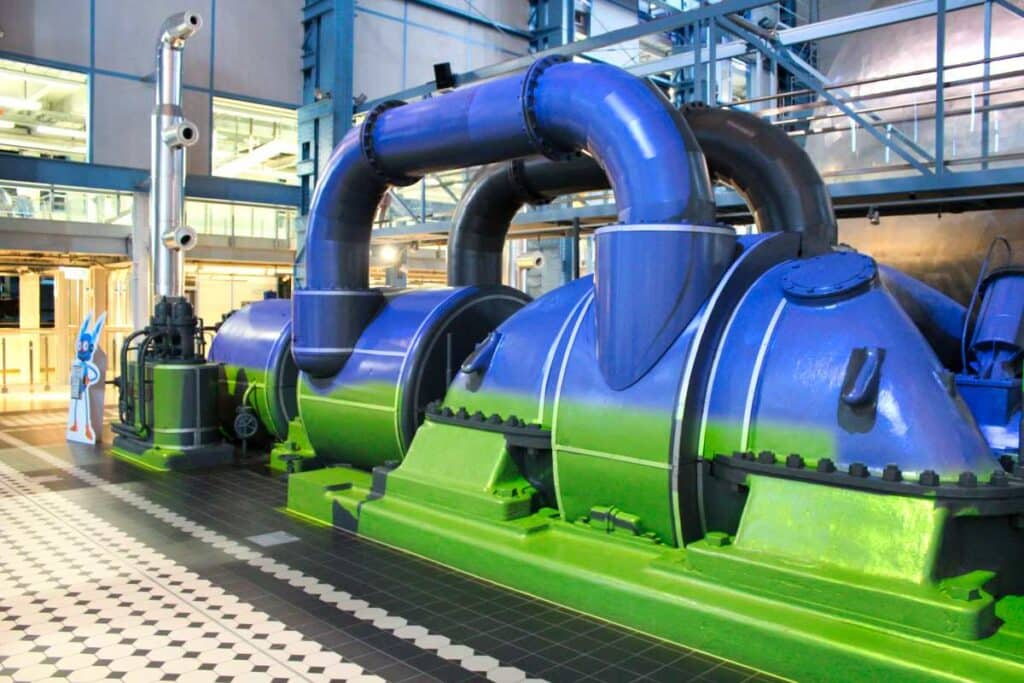
Centrum Nauki i Techniki
The science and technology center, which was named Tourism Project of the Year by the Polish Tourist Board in 2019, makes perfect use of the old power plant premises. On five levels, young and old can let off steam at numerous hands-on stations, learn all about energy generation and even walk through one of the old, 30-metre-high coal furnaces and take a look at the 20-ton turbines. Especially cool: You can take the elevator to the top of the cooling tower and enjoy a spectacular view of the entire city from there.
Centralne Muzeum Włókiennictwa
One of the first and most beautiful production facilities in Lodz was built in the 1820s by the Saxon industrialist Ludwig Geyer. Due to its white plaster (most other factories are made of brick), it was quickly given the name “White Factory” (Polish: Biała Fabryka), which it still bears today. The former factory site is now home to two exhibitions that could hardly be more different.
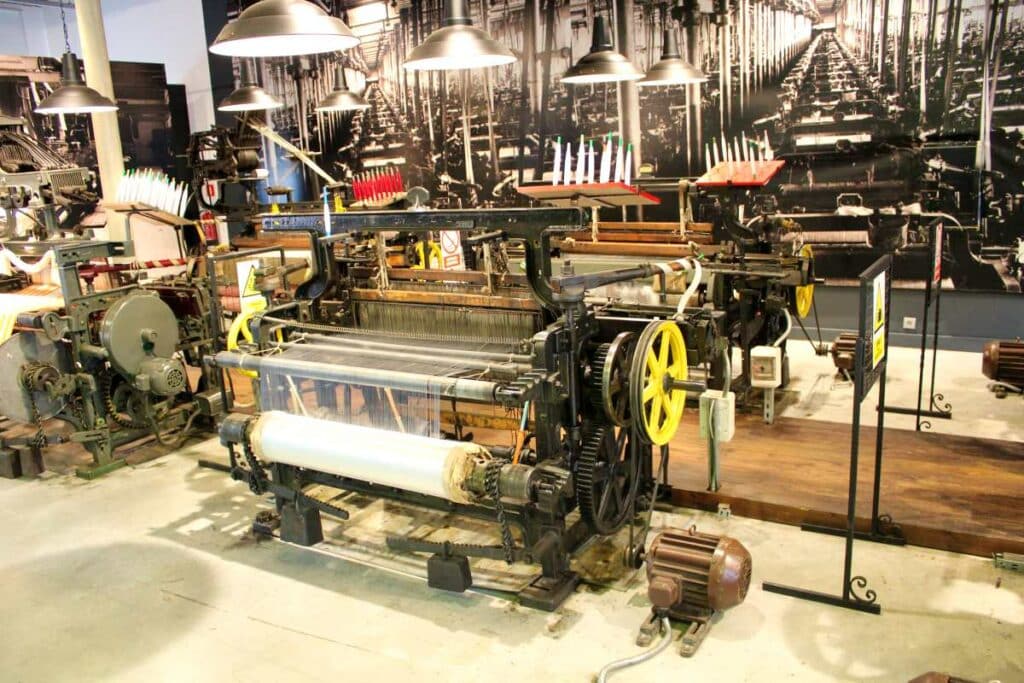
Miasto – Moda – Maszyna
City – Fashion – Machine is the name of the three-part exhibition in the main building of the white factory. In the first part, you can see historic looms, some of which are still in working order, and everything still looks as if the workers just went out for their lunch break. One floor above, you can see how closely the history of the town was linked to the textile industry. You can learn a lot about industrial Lodz from old photos, postcards and maps. Part of the exhibition is also dedicated to the workers’ strikes of 1981 and the decline of the industry after the fall of communism.

We particularly liked the fashion section. Here you are taken on a short journey through time and can see how tastes and the textiles produced in Lodz have changed over the course of time – including the appropriate background music.

Łódzki Park Kultury Miejskiej
Right next to the White Factory is the complex’s second museum, the Park of Municipal Culture. And we particularly liked it. After all the exciting industrial buildings, it feels a bit like being in a Scandinavian village. The wooden houses here used to be elsewhere in the city and were moved here together with a summer palace and a wooden church. The buildings show the living conditions in Lodz apartments over the course of the 20th century, always contrasting a simpler and a more luxurious way of life.

The whole thing is presented so realistically that you really feel like you’ve been transported back to those years. The church in the cultural park used to be a Protestant church in Nowo Solna (New Salt Field) near Lodz and is made almost entirely of wood inside. There are still (now Catholic) church services held here. The magnificent villa next to it once stood in Ruda, now incorporated into the city, a popular summer resort for wealthy Lodz manufacturers.

Ksieży Młyn
Some of the factories in Lodz are huge. However, Ksieży Młyn, which bears the beautiful German name Pfaffendorf, outshines everything once again. Karl Scheibler, a factory owner from the Eifel region, built a town within a town here from 1870 onwards, which had everything the workers needed to live. The English city of Manchester served as a model. It had its own power station, schools, cultural facilities, hospitals, countless residential buildings for the workers and, of course, a huge factory.
The concept was so ingenious that it was awarded the gold medal at the World Exhibition in Paris in 1878. Today you can stroll through the huge area, where there are several restaurants and parks and where events such as small sales markets take place from time to time. The famous Lodz Film Academy is also housed on part of the site today.
Muzeum Kinematografii
Polish cinema has an excellent international reputation and you’ve probably heard names like Roman Polański, Andrzej Wajda, Agnieszka Holland or Krzysztof Kieślowski. They all studied at the famous film school in Lodz. So what could be more obvious than to set up a cinematography museum here of all places? Of all the sights in Lodz, we liked this one the best. It is not simply housed in a modern museum building, but in the magnificent neo-Renaissance villa of the Scheibler family in Księży Młyn.
And it was not chosen at random, as it has already served as a filming location for several top national and international productions. The exhibition first takes you into the world of the precursors of cinema and film production up to the Second World War. Here you can see a cinematoscope, a magic lantern and a photoplasticon from the Fuhrmann company in Berlin, which still works and is one of only six examples left in the world. Also cool is the Oko device, a Polish invention that is both a camera and a projector and is constructed like a typewriter.
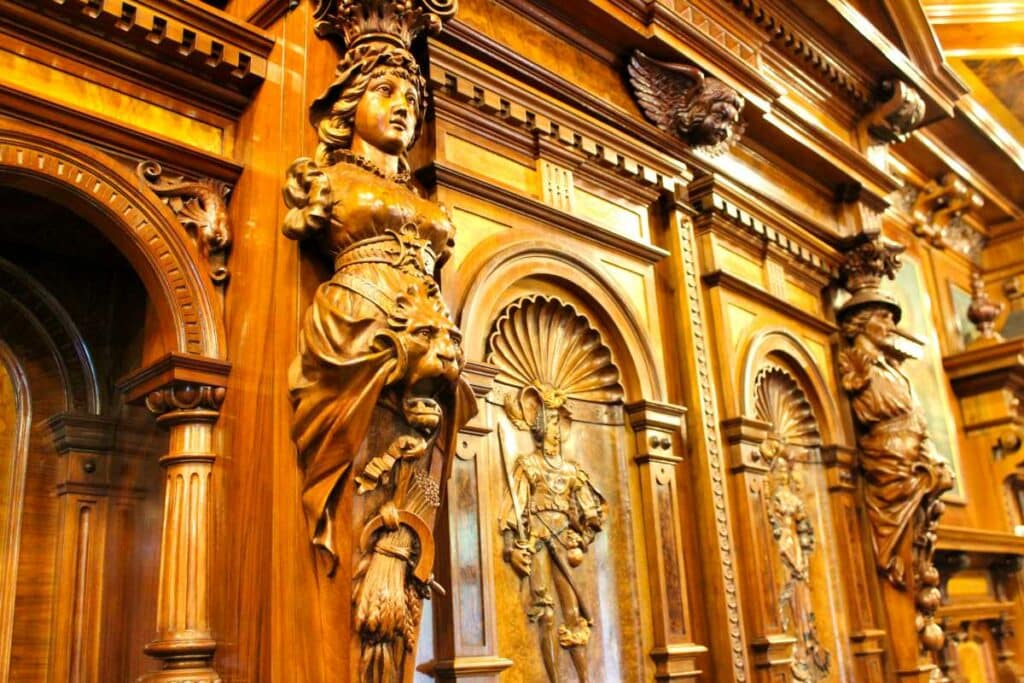
The tour then continues through the representative rooms of the palace with their ornate ceiling paintings, fireplaces, stucco decorations and wooden inlays. It is hard to believe that no “real” king lived here, but “only” the cotton king Scheibler and his family. If you have seen the film “Ziemia Obiecana” (“The Promised Land”) by Andrzej Wajda, the rooms will certainly look familiar to you.

The third and final part of the museum is dedicated to Polish cinema after 1945 and shows how Lodz developed into an internationally renowned film mecca. Here you can learn a lot about film studios such as the Wytwórnia Filmów Fabularnych or the Wytwórnia Filmów OPUS, marvel at costumes, scripts and other objects from well-known Polish productions and browse through film posters, which developed into an art form of their own in Poland at an early stage. And if you’ve always wanted to take a photo with an original Oscar statue, you can do that here too. It was donated to the museum by the producer of the film “Ida”, which sensationally won the Oscar for Best Foreign Language Film in 2015.
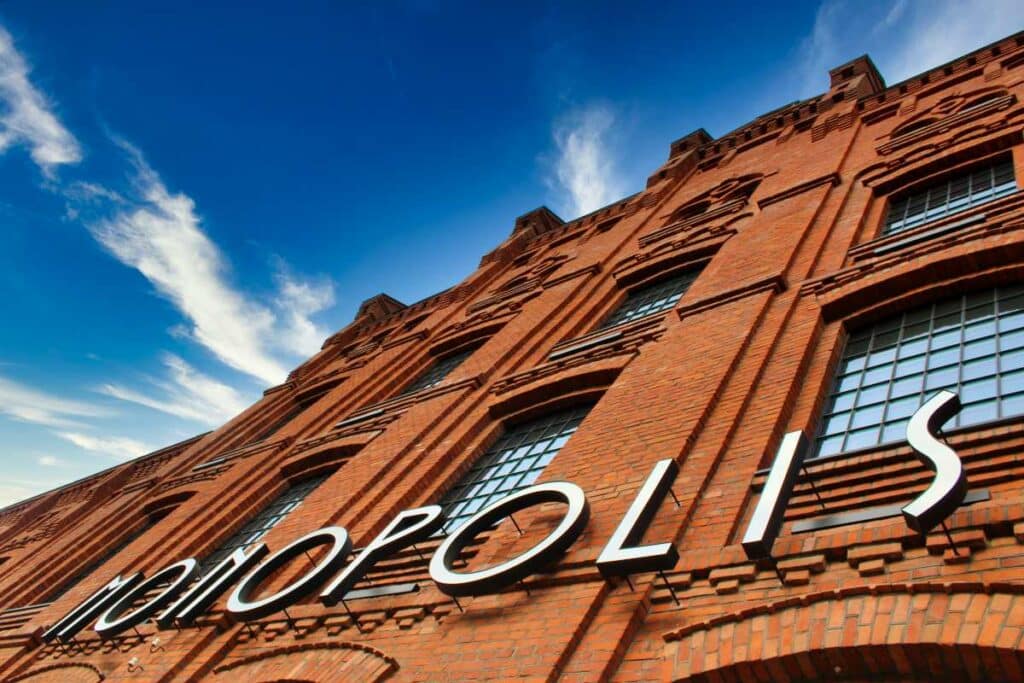
Monopolis
Numerous wool and cotton factories in Lodz have been converted into leisure and office areas. However, you can see for yourself at Monopolis that not only textiles but also luxury vodka was produced here. A small, free exhibition provides information about the history of the former vodka factory, and there are also several restaurants such as Arteria (see below), an art gallery, a concert stage and much more to discover. A place that is typical of Lodz – young, hip and constantly reinventing itself.
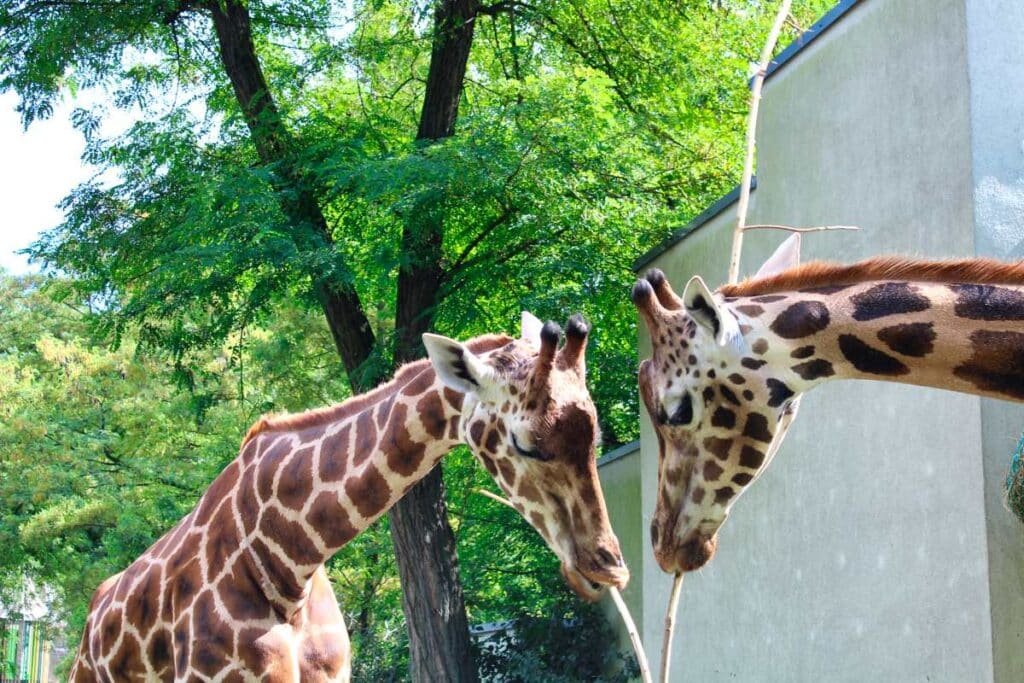
Zoo and Orientarium
Ok, maybe there’s a zoo in your home too. So why should you go to an animal park on vacation? Quite simply because the Orientariun, which opens in 2022, will make the zoo the most modern of its kind in Europe. Over 2000 animals of almost 700 species live here on around 16 hectares.
In the zoo, you can watch elephants bathing, walk through a tunnel under an aquarium with sharks, monkeys romp through a reconstructed temple ruin, giraffes come within a few meters of you, tigers strut around an airplane wreck – and, and, and. You can easily spend a whole day here without getting bored. This is especially true if you are traveling with children. Especially nice: the zoo is committed to preserving endangered species and all the animals have plenty of space.
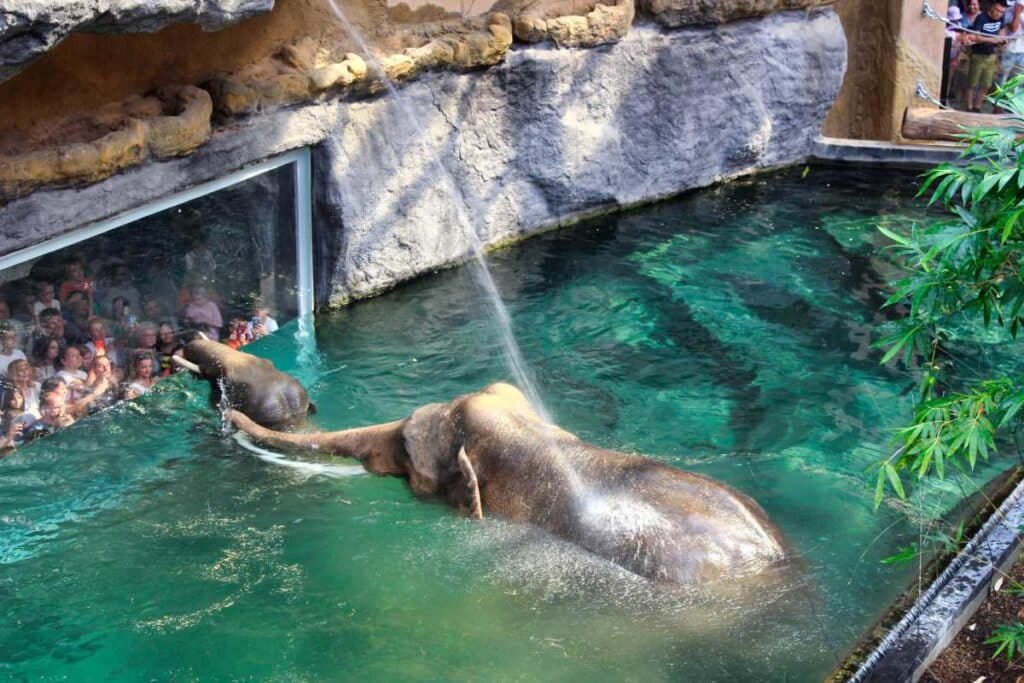
The children’s favorite and star of the zoo is Aleksander. The over 40-year-old elephant used to live in Münster, where he unfortunately broke a tusk and now acts as a mentor for young “only child” elephants.
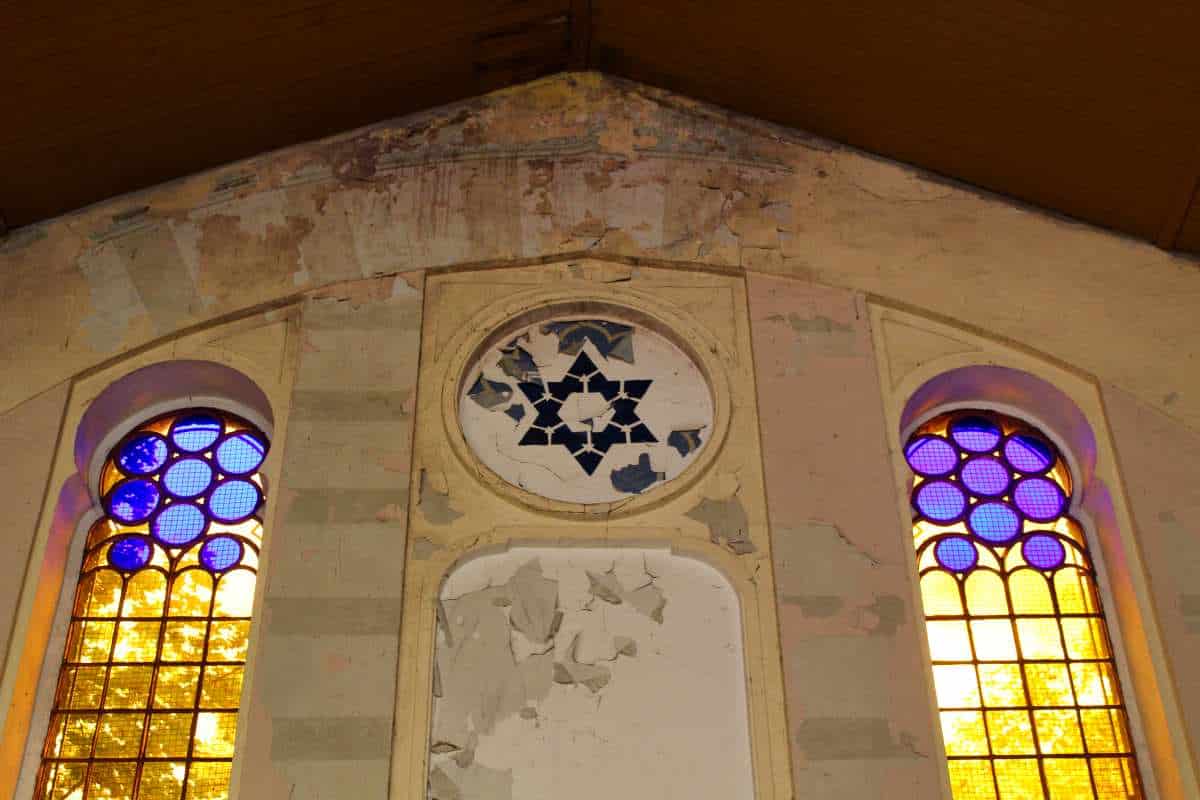

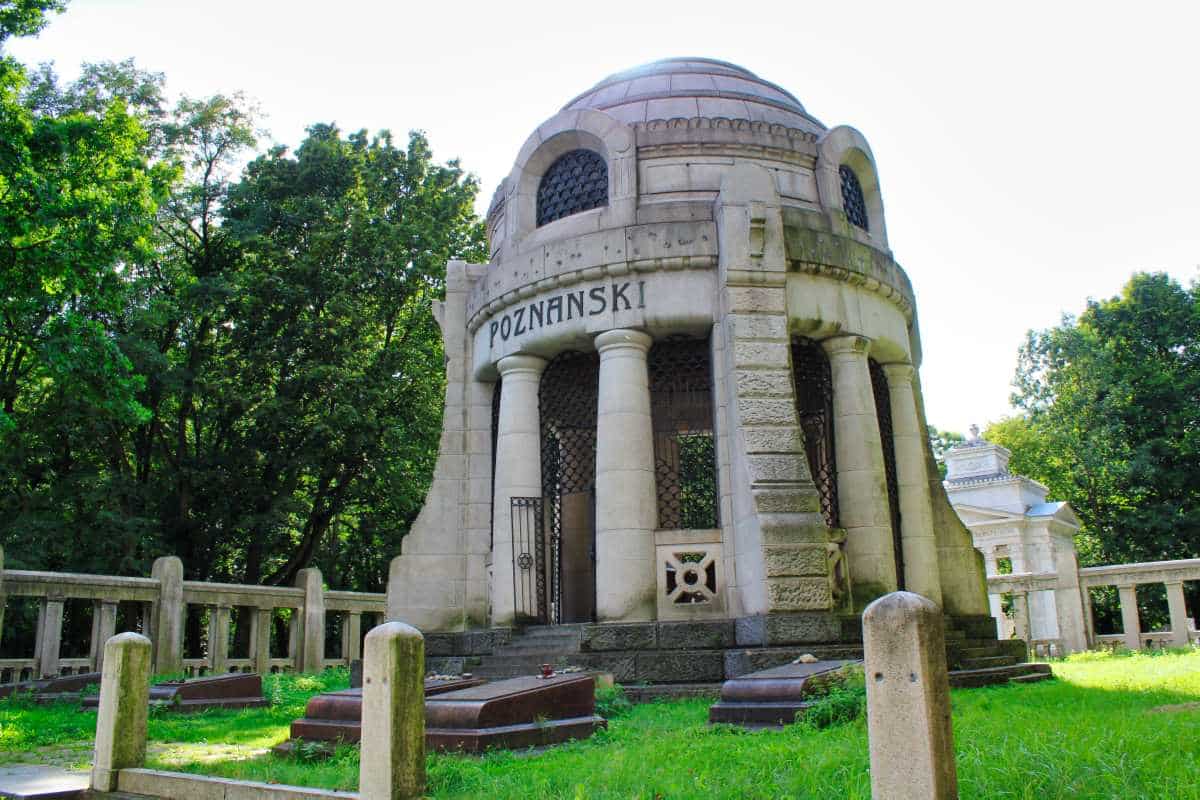
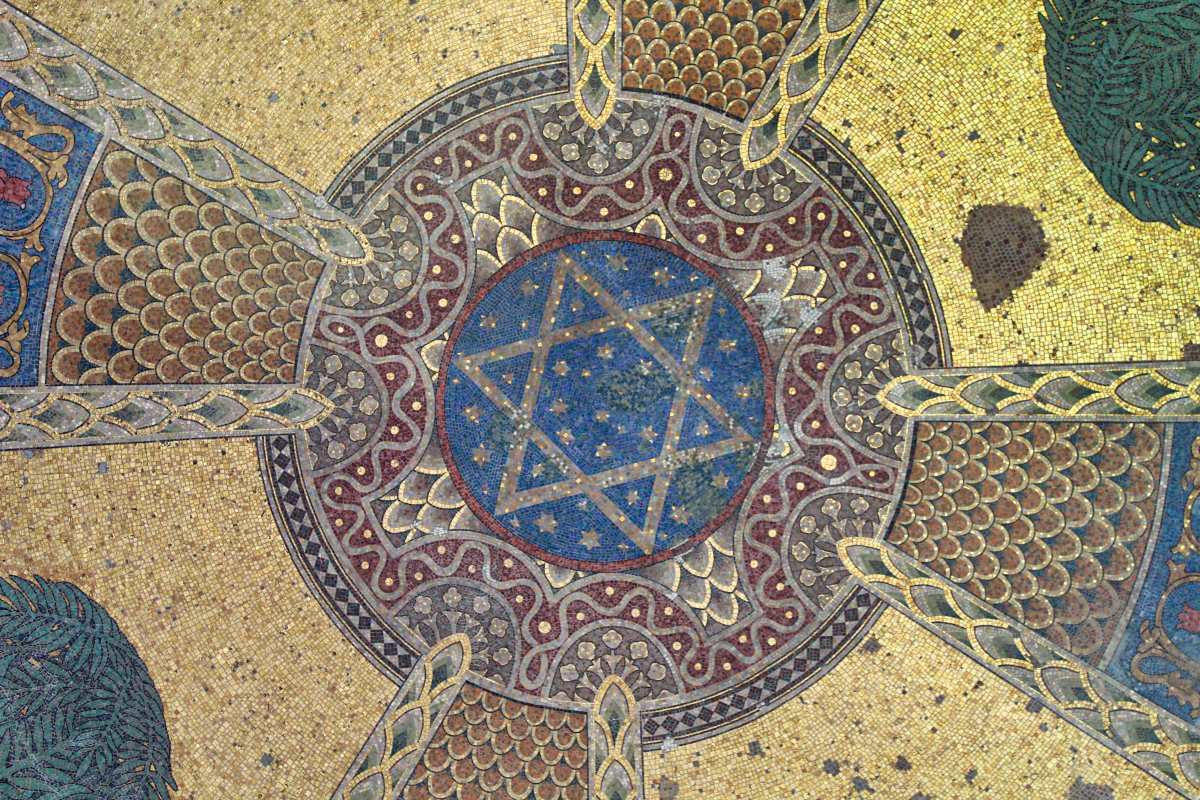
Jewish cemetery
With an area of 44 hectares, the Jewish cemetery in Lodz is one of the largest Jewish burial grounds in the whole of Europe. Up to 200,000 people (the exact number is not known) found their final resting place here. Directly at the entrance is the large funeral hall, after which you enter the area with its many gravestones, some of which are wildly overgrown, with their Hebrew, Polish and German inscriptions. Some graves, such as that of Izrael Poznański and his wife, resemble small temples. Here, for example, over 2 million mosaic tiles were processed. Funerals are still held at the cemetery, even though the Jewish community of Lodz now only has around 100 members.
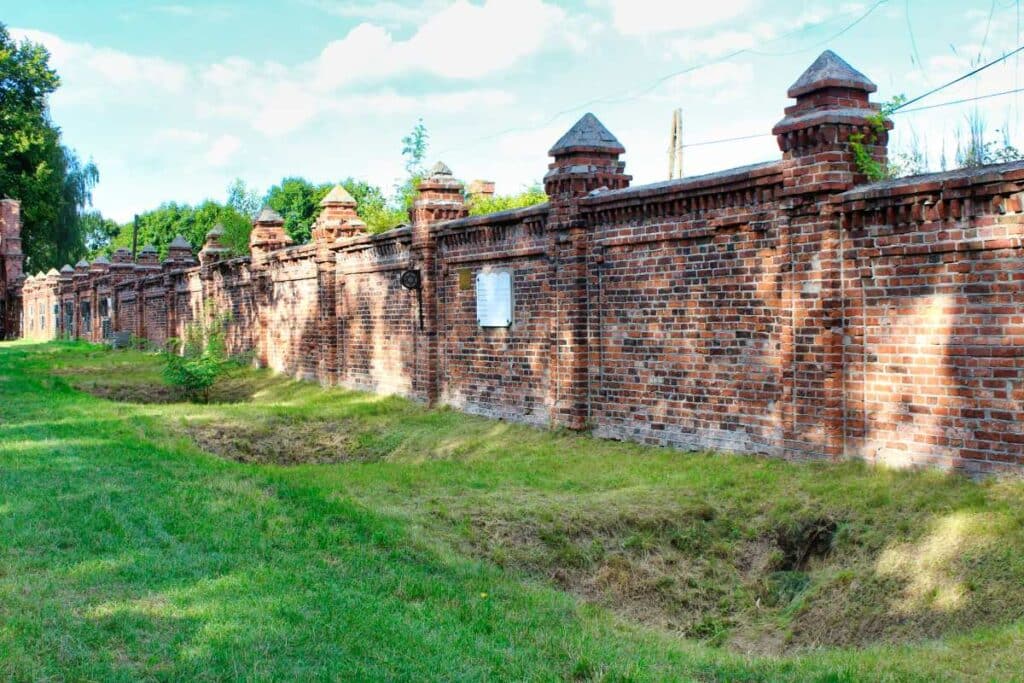
The so-called ghetto field, where over 40,000 Jews who perished here during the Nazi regime were buried, is both impressive and terrifying. As you walk along the wall, you’re sure to notice the pits. These were dug by the last survivors of the ghetto, who literally had to dig their own grave, but were then fortunately able to escape. The ghetto field is to be redesigned and provided with a memorial by 2024, the anniversary of the dissolution of the ghetto.
Important: Men must wear a head covering during their visit, and the area is closed on Friday afternoons and Saturdays due to the Sabbath.
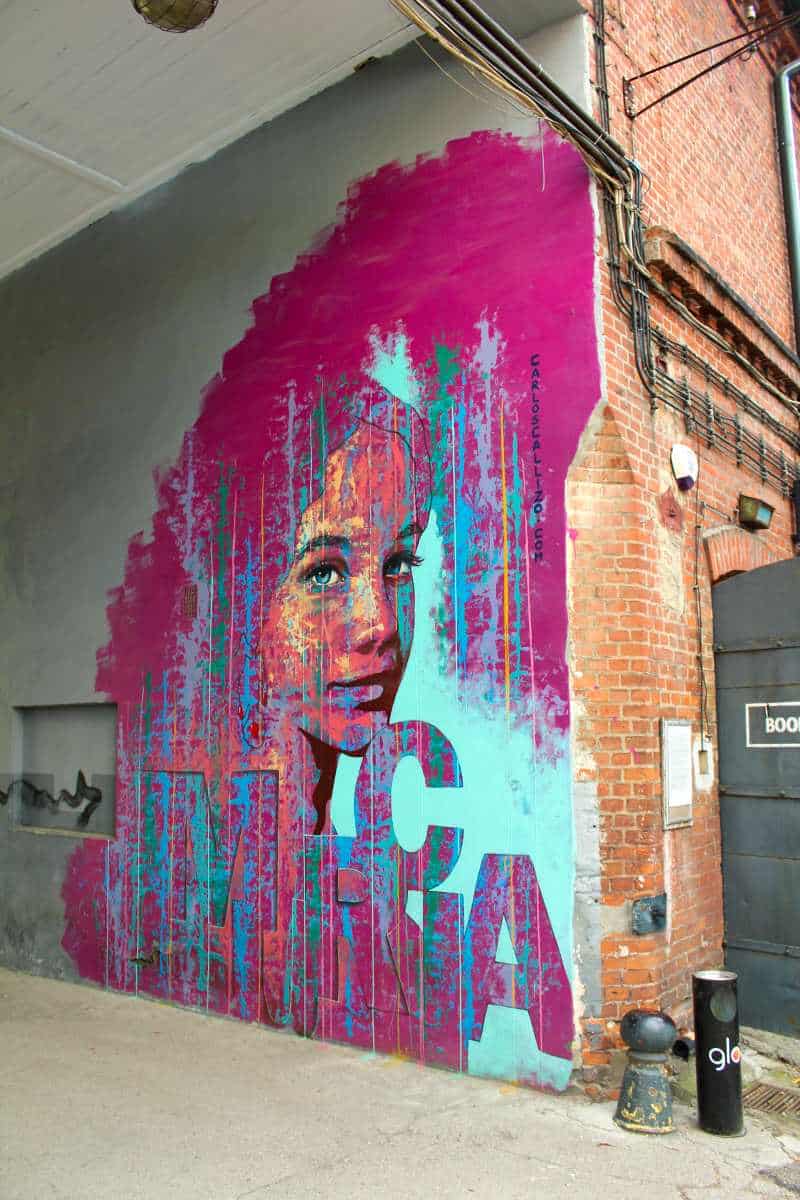
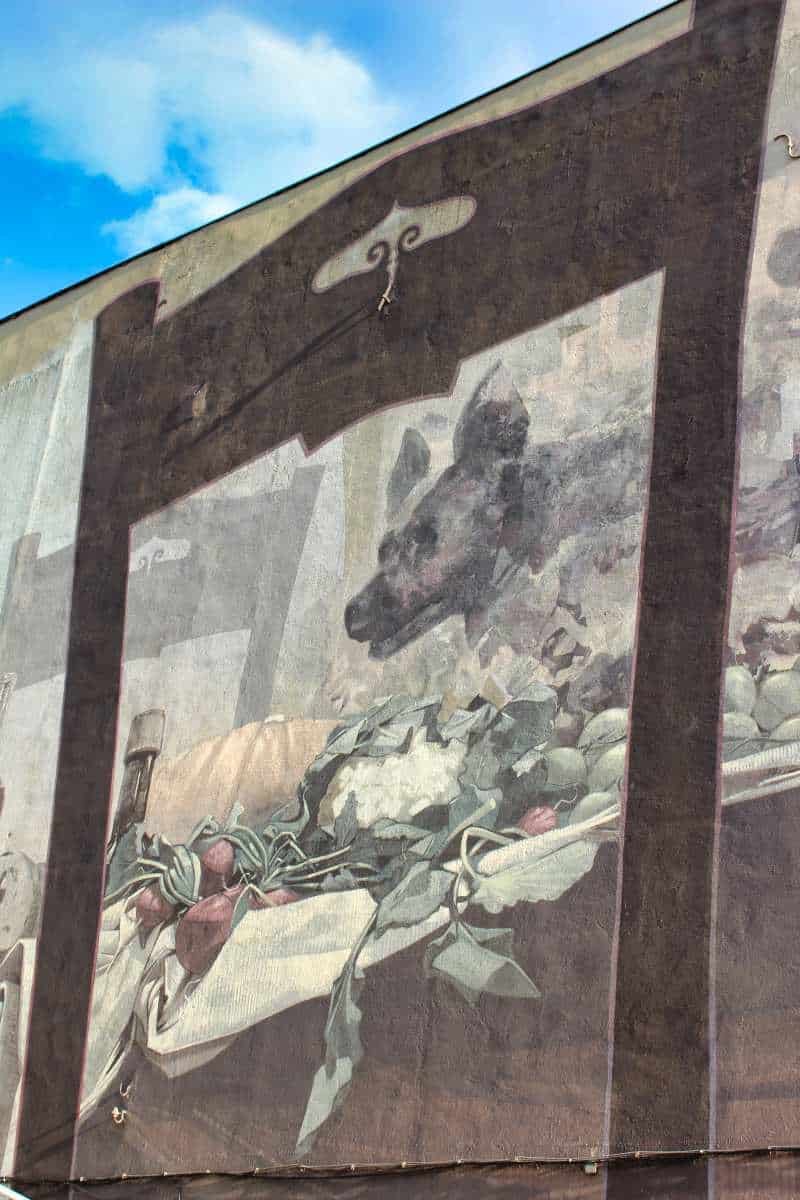

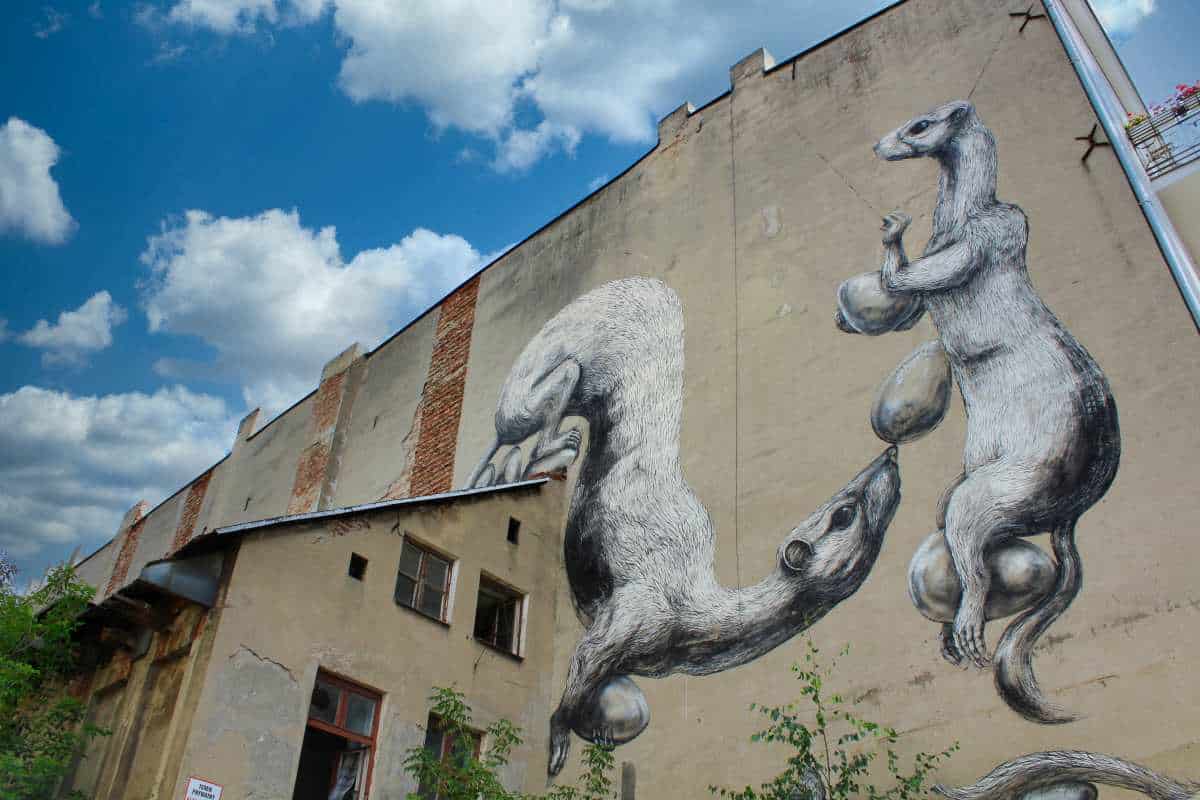
Street art in Lodz
You’ll quickly notice it on a walk through Lodz: You’ll find street art everywhere. For years, well-known Polish and international artists have been flocking to the city and beautifying it with their works. In the meantime, around 200 works have been created. At the tourist information office (see below), you can pick up a free map that will guide you to the artworks. And you can find more information about the pictures and their artists on this website.
Going out in Lodz
Visiting the many sights of Lodz can be quite exhausting and make you hungry and thirsty. So here are our tips for eating, drinking and going out.
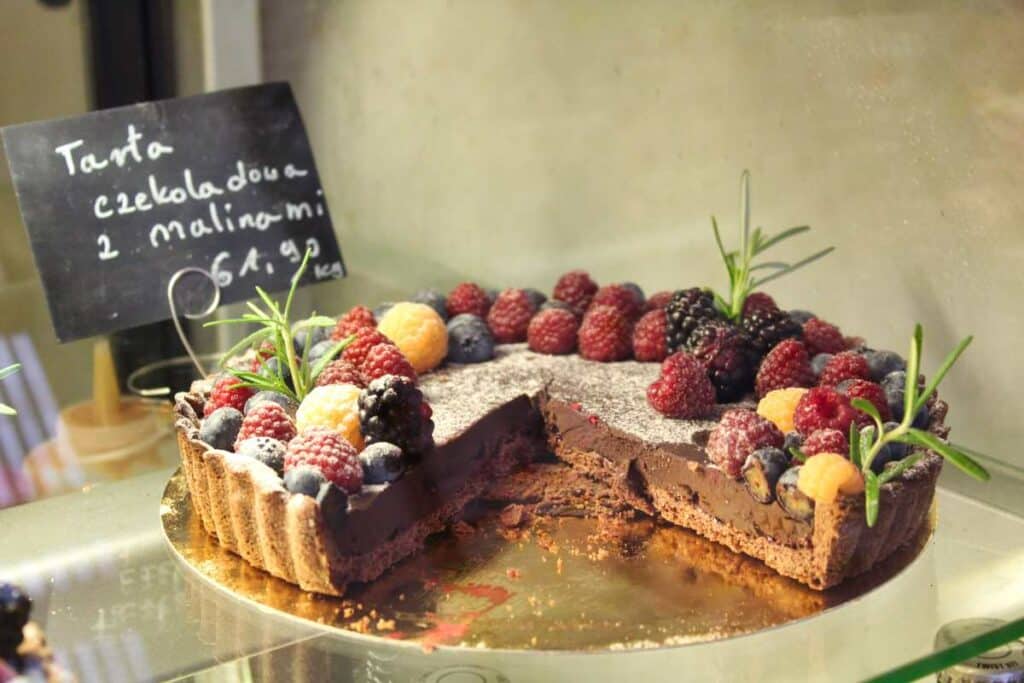
Restaurants and cafés
- Arteria, ul. Dr. Stefana Kopcińskiego 62a. Chic restaurant with a modern interpretation of Polish cuisine in Monopolis. You may have to dig a little deeper into your pockets here, but the food is really great. The house specialty is duck.
- Lodziarnia Cukiernia Wasiakowie, ul. Traugutta 2 This small café, which is even listed in Gault & Millau, spoils its guests with heavenly cakes, homemade ice cream and coffee specialties prepared to perfection.
- Klub Spadkobierców, ul. Piotrkowska 77 Welcome to the 19th century! In the former Goldfeder residence, time has stood still for a while. The food here is not cheap, but it is excellently prepared and the unique ambience of a carefully restored city palace is guaranteed to make the evening an experience.
- Restauracja Bułgarska 69, ul. Piotrkowska 69 In the middle of the Piotrkowska boulevard is a restaurant which, according to a waitress, is the only Bulgarian restaurant in the country. The menu is huge and includes many classics of Bulgarian cuisine, as well as beer from Bulgaria and a great view of the hustle and bustle on the boulevard.

Pubs and bars
- El Cubano, ul. Traugutta 3/11. Do you like Latin music? You can shake a leg at El Cubano on Fridays and Saturdays with delicious rum cocktails.
- Klubopiwiarnia, ul. Prezydenta Gabriela Narutowicza 7/9, where you can enjoy delicious home-brewed beer under the name Warkot, great pub food and always cool events and concerts. When we were there, for example, Michael Jackson’s Thriller video was being replayed.
- Rademenes, ul. Piotrkowska 63. You have to look a bit to find the pub in a backyard (look for the sign with the cat). It is home to one of the most unusual pubs in the city. The friendly owner rescues street cats from time to time, which then live in the pub. He himself used to live in the Czech Republic, so as well as Polish craft beers, there are also many beers from Bohemia.
Staying overnight in Lodz
- Puro Łódź, ul. Ogrodowa 16 How cool is that? The Puro right next to the Manufaktura is not only one of the chicest hotels in the city, it even has its own cinema, which guests can use free of charge on Fridays and Saturdays at 7 pm. In addition to stylish rooms, there is also a restaurant, a bar with great cocktails and a terrace from which you have the best view of the Poznański Palace.
Exciting city tours
- ŁódźiAnka. Anna Jóźwiak comes from Lodz and knows the city like the back of her hand. She will be happy to show you the most beautiful sights in Lodz in German and introduce you to her home town.
Tips and information
The staff at the tourist information office, which is located at 28 Piotrkowska Street, are super helpful and friendly. Not only can you find out all about the sights in Lodz here, but you can also get lots of other practical Lodz tips and stock up on lovely souvenirs. If you want to explore the city, we recommend the “Bilet Turystyczny” tourist ticket. It costs just 16 złoty, is valid for three days and allows you to use all streetcars and buses in the city.
We would like to take this opportunity to thank the Polish Tourist Office in Berlin and the Łódzka Organizacja Turystyczna for their support. Special thanks go to Anastasiia and Ania for their many tips and varied tours of the city.
How did you like the article? Please leave us a comment. Do you know any other sights in Lodz? Then let us know so that we can visit them next time.

